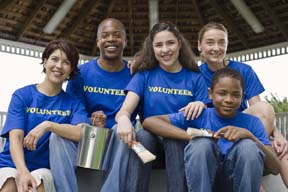

Protect Yourself from Volunteer Liability
Americans are a charitable group. One-fourth (24.9 percent) volunteer for a nonprofit or school*. Most people volunteer because they believe in a cause, want to help others or want to improve their community. Although volunteering might feel good, it’s not always risk-free.
The Risks
If your actions cause harm to another person, he or she can file a civil lawsuit against you. If a court determines you acted negligently, you might have to pay damages. This holds true even if you are volunteering your time, and even if you acted with the best of intentions.
What constitutes “negligence” varies with the situation, but it reflects what a prudent person would or would not do. In other words, if you do something that a prudent person wouldn’t do, such as letting young children in your care play with matches, you are negligent. And if you fail to do something a prudent person would do — such as taking matches away from those young children —you are also negligent.
Section II of your homeowners policy provides several types of liability coverage. In a standard policy, Coverage E will cover your liability if you are directly responsible for causing bodily injury and/or property damage to another through your “acts or non-acts.” This means your policy will pay for any damages or settlements you become legally obligated to pay. Your policy will also pay the costs of your legal defense (attorney and court costs) under separate limits.
The Volunteer Protection Act of 1997 also provides some protection. It limits volunteers’ liability for their acts or omissions if they:
- Were acting within the scope of their responsibilities.
- Had the appropriate license, certification or authority (where needed).
- Were not using a motor vehicle, vessel or aircraft.
- Were not acting in a willful, criminal or reckless manner.
This federal act applies in all states except New Hampshire, which opted out. States can enact stronger protections for volunteers, but must meet at least the minimum protections provided by the Act.
If you serve on a nonprofit board, the organization itself might provide some protection. The bylaws of most nonprofit organizations require the organization to “indemnify” board members’ costs if they are named in a lawsuit as a result of their board service. This means that the organization will reimburse your legal defense and settlement costs. However, a promise to pay doesn’t mean anything if the organization lacks the financial resources. If you are asked to serve on a nonprofit board—particularly one that works with vulnerable populations, such as children or the elderly—ask whether it has a directors’ and officers’ liability (D&O) policy. A D&O policy protects board members and other senior officials from liability claims. It will cover your legal defense costs, along with any settlements or damages you might have to pay.
If you are working as a volunteer for a nonprofit and your actions cause a bodily injury claim, your homeowners policy will generally respond to that. For example, your policy would cover you if you were coaching and accidentally tripped a player, causing her to break an ankle. Or if you tossed a ball and broke a car window, your policy would respond. But if you serve on a board or volunteer and are accused of things that are not property damage or bodily injury, your homeowners policy might not pay. The typical policy limits your liability coverage to claims of bodily injury or property damage. This would not include liability you incur while governing or managing on behalf of a nonprofit. Some policies geared toward higher-income individuals will cover this type of liability claim. Please review your policy or contact us for more information.
Employment Practices
Most liability lawsuits against nonprofit organizations and their volunteers involve negligence, strict liability or intentional misconduct, reports the Nonprofits’ Insurance Alliance of California (NIAC). Your potential for coverage becomes a bit murky when you are a board member and the organization itself is accused of employment discrimination, child abuse or sexual harassment. Employment practices lawsuits, or those involving hiring, firing, harassment and other employee issues, are the most common type of liability claim filed under nonprofit D&O policies. Not all D&O policies cover this risk exposure—be sure your organization’s D&O policy covers “employment practices liability.” If the organization doesn’t have the right insurance you could be personally liable.
It’s not hard to find competitively priced coverage for nonprofits — most major carriers offer it.
If you’d like information on what types of activities your homeowners policy covers, please call us for a policy review.
*2015 figures, Corporation for National & Community Service
The Insurance Checkup: Good for Your Financial Health
Protect Yourself from Volunteer Liability
Smartphone Use = Higher Insurance Rates?
The information presented and conclusions within are based upon our best judgment and analysis. It is not guaranteed information and does not necessarily reflect all available data. Web addresses are current at time of publication but subject to change. SmartsPro Marketing and The Insurance 411 do not engage in the solicitation, sale or management of securities or investments, nor does it make any recommendations on securities or investments. This material may not be quoted or reproduced in any form without publisher’s permission. All rights reserved. ©2015 The Insurance 411. Tel. 877-762-7877. www.theinsurance411.com